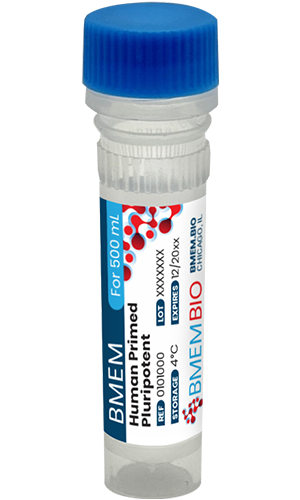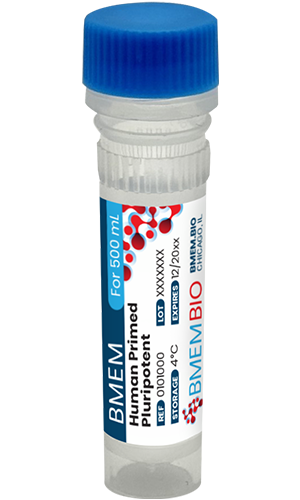Instructions for Use
Use sterile technique to prepare complete BMEM Human Primed Pluripotent (basal medium + supplement). Complete BMEM can be used straight from the refrigerator (4 °C) and should not be warmed to RT or 37 °C prior to use.
Incubator
Incubator atmosphere: Humidified atmosphere of 5% CO2. Hypoxia (5% O2) can be used but is not essential.
Ensure that proper gas exchange is achieved in culture vessels.
Directions for Use
Cells should be fed daily with BMEM. Typically, cells should be passaged every 4 days when they reach 70-80% confluence. When cells are adapted to BMEM (see below) a 1:20 or higher split ratio can be achieved.
Do not allow cells to become 100% confluent as it will result in slow growth and unreliable passaging.
ROCK Inhibitor
Addition of a ROCK inhibitor, such 10 µM Y27632 for 24 hours after passage is recommended to provide more reproducible passaging, reduce selective pressure, and allow higher split ratios.
Feeding Schedule
Daily media changes provide optimal cell growth and should be used when adapting cells to BMEM. Once adapted, BMEM is compatible with day-skipping, weekend-free, and no-change protocols – all feeding schedules will maintain pluripotency as long as cells are split 70-80% confluence.
Adaptation from Legacy Media
BMEM has been specifically modified to ease the transition from legacy media. Spontaneous differentiation during transition should not be seen.
The morphology of cells in chemically defined media such as BMEM differs from that seen in mTeSR1™, mTeSR™ Plus, and StemFlex™. Cells in BMEM exhibit a looser morphology and do not grow as colonies but as looser non-colony ‘continents’ which will become a monolayer if allowed to overgrow.
It is common for cells transitioning from the tight mTeSR1™ morphology to the loose chemically defined morphology to be mistaken for spontaneous differentiation. This is not the case, spontaneous differentiation should not be seen in BMEM cultured cells and no ‘picking’ should be expected.
To Adapt Cells from Legacy Media
The goal is to adapt the cells as fast as possible to BMEM. The faster the cells are growing before the adaptation (including pre-freezing), the easier the process will be. When switching to a chemically defined condition, cells will lose their mTeSR-type dense colony morphology, while remaining highly pluripotent.
NOTE: The aim is to eliminate the mTeSR-type dense colony growth. Switching media mid-passage or using 50:50 mixes of media results in slower adaptation. Starting from the second passage in BMEM, cells should present a different morphology compared to those not cultured in chemically defined conditions.
Product Use
For Research Use Only.
Not for diagnostic procedures.
Reference
1. Lyra-Leite, D.M., Copley, R.R., Freeman, P.P., Pongpamorn, P., Shah, D., McKenna, D.E., Lenny, B., Pinheiro, E.A., Weddle, C.J., Gharib, M., et al. (2023). Nutritional requirements of human induced pluripotent stem cells. Stem Cell Reports 18, 1371-1387. 10.1016/j.stemcr.2023.05.004.
Troubleshooting
Cause: Split ratio was too high.
Solution: Obtain new cells and split more gently at a variety of ratios.
Cause: Media is too old.
Solution: Complete media should be used within 30 days.
Cause: Cells were either overconfluent (>90%) or underconfluent (<60%).
Solution: Adjust split ratio of hiPSCs to achieve 70-80% confluency after 4 days of growth.
Cause: No extracellular matrix on the plates or matrix may be too old and have dried out.
Solution: Discard old plates and replace.
Cause: Cells were overconfluent before passaging and became contact inhibited.
Solution: Adjust split ratio of pluripotent cells to achieve 70-80% confluency after 4 days of growth.
Cause: Cells were kept in dissociation solution for too long.
Solution: Follow the specific dissociation times for each dissociation reagent.
Cause: Spontaneous differentiation is usually caused by slow growing cells in suboptimal conditions, usually that were grown overly confluent before passaging.
Solution: Obtain new cells and split them at 70-80% confluency.
Cause: Source of adaptation cells was not pure.
Solution: Obtain a new batch of cells that are guaranteed to be pluripotent before starting the




